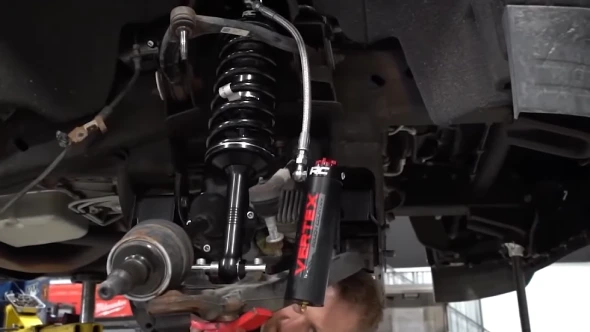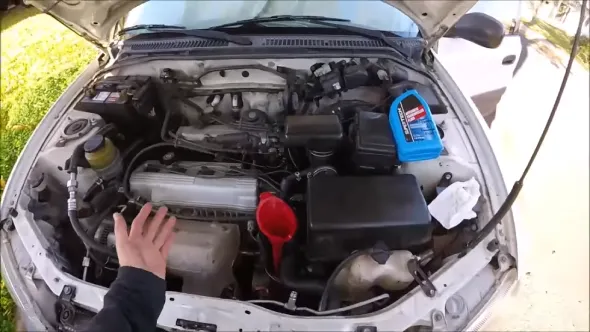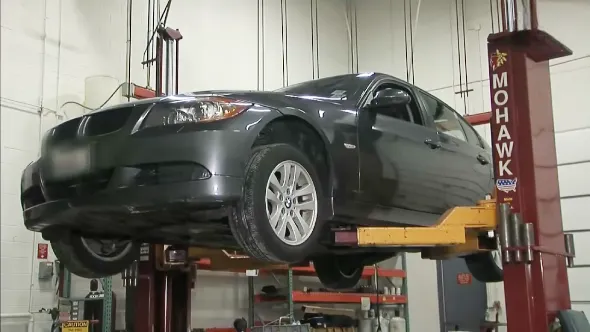Last Updated on March 13, 2023
Lift kits are more common on RVs, SUVs, and Jeeps. With lift kits, your car changes shape and size, affecting many different internal components indirectly. Maybe you’re wondering if adding a lift kit to your truck/car would affect the transmission fluid level.
A lift kit causes the car to sit at a different angle. It may cause the transmission fluid to pool in one area of the transmission, making it appear lower than average. But careful installation and regular maintenance can help prevent this from happening.
To make sure your transmission fluid level doesn’t suffer, ensure you get the right lift kit, install it right, check the transmission fluid level before and after installation, and monitor it as you drive cautiously after installation. Let’s look at each of these in depth.
How Can Adding a Lift Kit Affect Transmission Fluid Level: Easy Steps

Adding a lift kit to your vehicle can be an exciting and rewarding process, but taking the right steps to ensure you don’t affect the transmission fluid level is essential. Here are a few steps to follow when adding a suspension lift kit without impacting transmission fluid:
Step 01: Choose the Right Lift Kit
When choosing a lift kit for your vehicle, it is crucial to consider compatibility with the transmission and ensure that it does not interfere with the fluid levels or distribution.
It’s best to consult a professional mechanic or installer to ensure that you select the right lift kit for your car. The mechanic can also recommend additional components and give advice on installation that may be necessary due to your vehicle’s unique specifications.
Step 02: Install the Lift Kit Properly
Proper lift kit installation is critical to avoid any issues with transmission fluid levels. Make sure all instructions are followed carefully, and use only high-quality components. This will help ensure that all parts are compatible and will function as designed.
Also, check how much space is available between the lift components and other mechanical parts of the vehicle so they can move freely while driving, avoiding any unwanted friction.
Step 03: Check the Transmission Fluid Level
After installing a lift kit, always check the transmission fluid level to ensure it is at its recommended amount. If there are low fluid levels after installation, you must add more until it meets manufacturer specifications.
To do this accurately, refer to your car’s owner’s manual for detailed instructions on how much fluid must be added and where it should be done. It is advised that once done adding new fluid, you must check again after driving for some time and topping up if necessary until desired levels are reached.
Step 04: Drive Cautiously
When driving with a lift kit installed, it is vital to take extra caution when behind the wheel. Driving too fast or making sudden maneuvers can cause the transmission fluid to move around inside the system, which could lead to spillage and a decrease in pressure levels.
Also, avoid taking corners quickly or making sharp turns, as these movements could force oil away from certain components and cause them to fail prematurely. Always obey speed limits and drive responsibly, especially when driving with a lifted vehicle.
Should You Check the Transmission Fluid with the Engine Running?

Checking a vehicle’s transmission fluid under normal operating conditions is important. Checking the fluid level when the engine is cold may lead to false readings, indicating insufficient fluid present.
To receive accurate results, waiting until the engine has been running for several minutes is recommended to allow time for the transmission fluid to reach its proper temperature. This will ensure that an accurate fluid measurement can be taken easily and without any discrepancies.
The temperature at which a vehicle operates can significantly impact how effectively its transmission system works. When a vehicle is turned off, its internal temperature decreases gradually, leading to changes in the viscosity of fluids like transmission oil and coolant.
Over time, these changes can cause serious problems if left unaddressed, including a lack of lubrication for moving parts and decreased cooling efficiency for required parts.
Allowing an engine to run for a few minutes before checking transmission fluid helps maintain its optimal operating temperature and thus allows all system components to perform more efficiently over time.
Another benefit of checking transmission fluid when the engine is running versus when it is cold is that it gives you more insight into how well your car performs overall.
When you check your car’s fluid while running, you’ll be able to see how much pressure builds up within the system as components begin working together at higher temperatures.
This type of pressure test helps indicate any weak points in performance or areas where maintenance or repair may be necessary before further issues occur.
Can You Fill Transmission Fluid through the Dipstick Hole Lifted Vehicle?

Lifted vehicles have dipstick holes for filling transmission fluid. Inserting a long funnel into the dipstick hole allows you to add automatic transmission fluid in small increments until the level reaches “warm.”
It is important to remember not to overfill or spill transmission fluid on any hot engine parts while doing this procedure. When filling the fluid through the dipstick hole of a lifted vehicle, it is important to use caution.
Be sure that there is no debris blocking the dipstick tube, as this could cause an overflow and potential damage to the engine. The oil should also be at room temperature before attempting to fill it up with new oil, as hot oil could cause serious injury if spilled on your skin.
Also, use an appropriate type of transmission fluid for your particular vehicle’s make and model. Different vehicles may require specific types of fluids, and using an incorrect one could potentially lead to damage or worse.
Once you have ensured all of these safety measures have been taken, filling up the transmission fluid through the dipstick hole is relatively simple. Simply insert a long funnel in the dipstick hole and add in small increments until it reaches the warm line indicated on the dipstick.
Make sure that you check periodically to ensure that you are not overfilling or spilling any transmission fluid onto any hot engine parts throughout this process. Once finished, re-insert the dipstick and restart your engine to test if it has been filled correctly with no signs of leakage or improper operation.
Does a Lift Kit Void the Transmission Warranty?
Whether a lift kit or level kit voids the transmission warranty is important to consider when modifying your vehicle. A lift or level kit is a suspension system modification that raises your vehicle’s body, allowing easier access to off-road terrain.
While installing a lift or level kit does not directly change any part of the vehicle’s transmission, it can cause stress on various components, such as CV axles and U-joints.
The answer to this question depends largely on the policies of the specific manufacturer warranty. Generally, most manufacturer warranties will not cover any damage caused by modifications made outside of their specifications.
This means that any damage caused or worsened by the installation of a lift or level kit may not be covered by the manufacturer’s warranty if they determine that it was responsible for causing said damage.
It’s important to note that simply adding a lift or leveling kit shouldn’t void a warranty. Warranty coverage is denied only for parts affected by this modification. Before installing this type of modification, consumers should also understand the manufacturer’s terms and conditions.
Why Is There No Dipstick for Transmission Fluid in My Lifted Truck?

Contemporary vehicles are designed without standard transmission dipsticks due to the increasing popularity of “sealed-for-life” transmissions.
This means they are not meant to be regularly serviced or have their fluid levels checked, as with older models. This can cause concern for vehicle owners, particularly those who own lifted trucks.
Lifted trucks are typically used off-road and require more challenging components than conventional vehicles. The sealed-for-life transmission may not last as long in these conditions due to the increased stress placed on it by uneven terrain and other hazards that come with off-roading.
As a result, manufacturers often opt out of putting dipsticks in lifted trucks and instead focus on tougher components that can withstand more wear and tear.
Enjoy Maximum Thrills and Safety with Your Lift Kit Modification
Investing in a lift kit modification for your vehicle is an exciting prospect. This is because it will give you the maximum bang for your buck. It’s important to consider how alterations will affect other components like your transmission fluid levels when taking on this project.
Therefore, choosing an appropriate lifting kit for your RV, Jeep, or SUV is essential. Also, ensure a proper installation, check and monitor your chosen fluid regularly before and after mounting the lift kit, and take care when driving after setup.
If you follow all these steps correctly, you can be confident that you are making smart modifications to enjoy all the thrills of upgrading without risking any transmission fluid damage.
